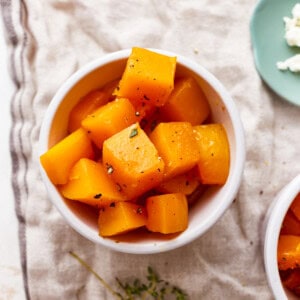This maple-infused Roasted Butternut Squash recipe is so sweet and tender, and baked to perfection. It’s the perfect Thanksgiving side dish, but just as good any night of the year!

This post may include affiliate links that earn us a small commission from your purchases at no extra cost to you.
What’s in this Roasted Butternut Squash Recipe?
This squash is baked in a maple, butter, and broth mixture, and it adds so much flavor. Plus the natural sweetness of the butternut squash comes out while roasting, and it all combines so well. Top it with a bit of crumbled feta cheese after baking, add some thyme or parsley, and wow! I could eat this every night.
- Butternut Squash: Nutty, earthy, and slightly sweet, this bright orange squash is the perfect side!
- Unsalted Butter: Adds richness and buttery flavor to the squash.
- Chicken Broth: Helps keep the squash moist and adds umami flavor. Feel free to use vegetable broth instead to keep this dish vegetarian!
- Maple Syrup: Adds a touch of sweetness and nuttiness. Make sure to use 100% pure maple syrup!
- Salt + Pepper: Enhance the flavor of the squash.
- Feta Cheese: An optional topping that adds a bit of tang and funk to the dish!
Pro Tip: Top your squash with fresh parsley or thyme to add a herbaceous note!
Variations on Roast Butternut Squash
This winter squash recipe is so good as it is, but you can add chopped toasted or candied nuts to take it to the next level.
You can also turn it into more of a maple mashed butternut squash, a butternut squash puree, or you can even roast it (cut in half) with skin on and then scoop out the flesh. And of course, you can roast the seeds too. There’s a lot of variety with this hardy winter squash!

While you don’t technically need to peel the squash, I prefer to, as the texture of the skin can be offputting on the cubes.
While the recipe specifically calls for butternut squash, you can experiment with other types of winter squash, such as acorn squash or kabocha squash. Just keep in mind that the cooking time may vary slightly depending on the type of squash used.
If your squash is soggy, it’s likely that you used too much broth. You want to coat the squash cubes, but not smother them.
The cooking time provided in the recipe is an estimate. To determine if the squash is tender, you can insert a fork or knife into a few pieces. If it goes in easily and the squash feels soft, it is likely done. Cooking times may vary depending on the size and freshness of the squash, so adjust accordingly.
This dish is best served immediately after baking. However, you can prepare the ingredients in advance and assemble them just before baking to save time. Avoid baking it too far in advance, as the texture of the squash may become overly soft or mushy upon reheating.

How to Store and Reheat
Store leftover roasted butternut squash in an airtight container in the refrigerator for up to 4 days. Reheat in a covered baking dish in a 350°F oven for 15-20 minutes. I do not recommend freezing this dish, as the texture of the squash will change significantly once thawed.
Serving Suggestions
This butternut squash recipe is the perfect Thanksgiving side. Serve it alongside a traditional turkey, stuffing, mashed potatoes, cranberry sauce, green bean casserole, creamed corn, and gravy.
But this squash is also great any time of the year served alongside grilled ribeyes, roast chicken, pork loin, maple glazed salmon, or honey ham. Keep that maple flavor going with a side of maple bacon Brussels sprouts or serve simply with roasted veggies.

Roasted Butternut Squash (Maple Butternut Squash)

Equipment
- 9×13 Baking Pan
Ingredients
- 3½ cups butternut squash peeled, seeded, and cubed (click for guide)
- 4 tablespoons unsalted butter melted (½ stick)
- 1 cup low-sodium chicken broth or turkey broth
- ¼ cup pure maple syrup
- ½-1 teaspoon coarse kosher salt to taste
- ½ teaspoon ground black pepper
For Garnish
- Chopped fresh parsley or thyme optional
- Crumbed feta cheese optional
Instructions
- Preheat oven to 400°F. Spray a casserole dish with cooking spray.
- Add the squash to the casserole dish, then pour the melted butter, broth, and syrup over the squash.3½ cups butternut squash, 4 tablespoons unsalted butter, 1 cup low-sodium chicken broth, ¼ cup pure maple syrup
- Add salt, pepper, and herbs (if using).½-1 teaspoon coarse kosher salt, Chopped fresh parsley or thyme, ½ teaspoon ground black pepper
- Loosely cover and bake 15 minutes.
- Take off cover, stir and bake 15 more minutes, or until squash is tender (see notes).
- Once the liquid is thickened, pour the syrup, broth and butter reduction over the squash.
- Top with crumbled feta cheese if desired and serve hot.Crumbed feta cheese
Video
Becky’s Tips
- Note: Half the squash is used in this recipe. If using the entire squash, add ½ cup more broth and ⅓ cup syrup.
- If the liquid around the squash is getting too dry, add a little broth.
- If after cooking the liquid around the squash is still a little soupy, use a slotted spoon to transfer the squash to a bowl. Then, pour the reserved liquid in a saucepan and boil until it is thickened and reduced.
Nutrition information is automatically calculated, so should only be used as an approximation.













What step do you add the butter in?
Hi Debbie, you add the butter along with the syrup and broth. hope that helps! thanks so much for stopping by :)
Hey Debbie, I have updated the recipe. So sorry for the error and thank you very much for letting me know.
How much butter? The recipe doesn’t specify.
Hi Rita…we are so glad you noticed that!! so sorry we didn’t specify. mom updated the recipe. hope you enjoy it! thanks for stopping by!